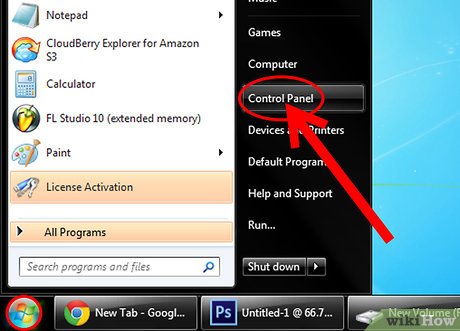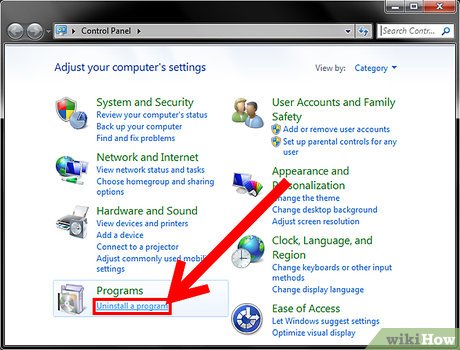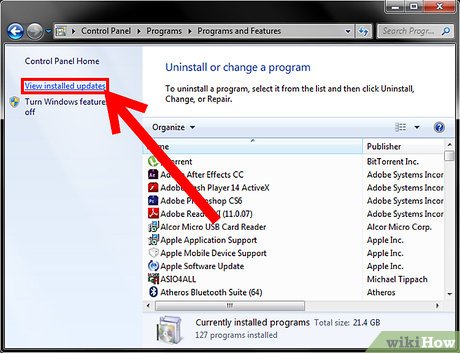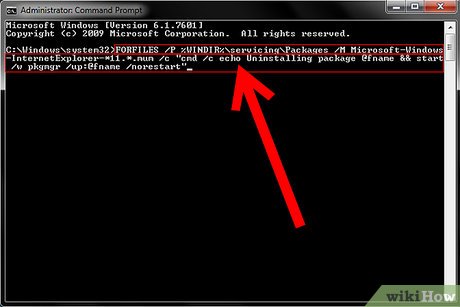How to Uninstall Internet Explorer 11 on Windows 7
Use Control Panel

Open the Control Panel. You can open Control Panel from the Start menu.

Open program manager. Click the "Uninstall a program" link if you're viewing in Category mode, or "Programs and Features" if you're viewing in Icon mode (Icon). A list of programs installed on the computer will appear.

Open the list of installed Windows updates. Click the "View installed updates" link on the left side of the window. A list of all installed updates for Windows will appear. Since Internet Explorer is also a Windows service, any updates will also be listed here.

Look for Internet Explorer 11. You can scroll down to find it, or type "Internet Explorer" into the search field at the top of the window.

Uninstall Internet Explorer 11. You can select the Internet Explorer 11 item and click the "Uninstall" button, or right-click the item and select "Uninstall".
Maybe User Account Control will ask you again. Confirm that you want to uninstall the update by clicking Yes.


Wait for the uninstallation process to complete. Uninstalling Internet Explorer 11 may take a few minutes. After the uninstallation is complete, click Restart Now to restart the computer and complete the process.
Internet Explorer will return to the previously installed version. Could be Internet Explorer 10, 9, or 8.

Hide updates. If you don't want to keep being prompted to reinstall Internet Explorer 11, you can skip it by hiding it from Windows Update.
Open Control Panel. You can open Control Panel from the Start Menu.

Select "Windows Update". If you are viewing in Category mode, Select "System and Security", then select "Windows Update".

Click the " # optional update(s) available" link (number of available updates).

Right-click on Internet Explorer 11. Select "Hide update".

Install another version of Internet Explorer. After downgrading to an older version of Internet Explorer, you can upgrade to any higher version if you want. For example, if you uninstall Internet Explorer 11 and return to Internet Explorer 8, you can install Internet Explorer 9 or 10 manually.
Use Command Prompt

Open an elevated Command Prompt. Click Start Menu, click Accessories, right-click Command Prompt, then select "Run as administrator".

Copy and paste the following command. This command will uninstall Windows Explorer updates:
FORFILES /P %WINDIR%servicingPackages /M Microsoft-Windows-InternetExplorer-*11.*.mum /c "cmd /c echo Uninstalling package @fname && start /w pkgmgr /up:@fname /norestart"
Paste the above command and press↵ Enter
Accept errors. You may receive some error messages during command execution. You will have to click OK every time the error window appears.

Restart the computer. When you return to the Command Prompt screen, the uninstallation process is complete. You need to restart your computer to complete the process.
Hide updates. If you don't want to keep being prompted to reinstall Internet Explorer 11, you can skip it by hiding it from Windows Update.
Open Control Panel. You can open Control Panel from the Start Menu.

Select "Windows Update". If you are viewing in Category mode, Select "System and Security", then select "Windows Update".

Click the " # optional update(s) available" link.

Right-click on the Internet Explorer 11 entry. Select "Hide update".

Install another version of Internet Explorer. After downgrading to an older version of Internet Explorer, you can upgrade to any higher version if you want. For example, if you uninstall Internet Explorer 11 and return to Internet Explorer 8, you can install Internet Explorer 9 or 10 manually.
You should read it
- Uninstall Internet Explorer 8 in Windows 7
- How to remove Internet Explorer 10 in Windows 8
- How to Uninstall Internet Explorer 11 for Windows 7
- The 7 most common problems in Internet Explorer
- Anti-uninstall extension on Google Chrome, Firefox and Internet Explore
- Instructions to remove Internet Explorer 10 in Windows 8
- How to enable Internet Explorer mode on Microsoft Edge
- How to Fix Internet Explorer Windows Not Responding
May be interested
- How to Update Microsoft Internet Explorer
 this article shows you how to update microsoft's internet explorer browser. after the release of internet explorer 11, microsoft stopped supporting internet explorer and did not continue to create any other updates. internet explorer browser is only available on windows 7, windows 8.1, and windows 10 although microsoft edge is the default browser of this operating system.
this article shows you how to update microsoft's internet explorer browser. after the release of internet explorer 11, microsoft stopped supporting internet explorer and did not continue to create any other updates. internet explorer browser is only available on windows 7, windows 8.1, and windows 10 although microsoft edge is the default browser of this operating system. - The 7 most common problems in Internet Explorer
 sometimes you may find yourself in situations where you must use internet explorer. let's take a look at quick fixes for common internet explorer issues so you don't have trouble experimenting with this old browser.
sometimes you may find yourself in situations where you must use internet explorer. let's take a look at quick fixes for common internet explorer issues so you don't have trouble experimenting with this old browser. - Microsoft urges Windows users to upgrade to Internet Explorer 11 browser
 microsoft has decided to create an opportunity for users to upgrade to ie11 when releasing an update of this operating system version via windows update.
microsoft has decided to create an opportunity for users to upgrade to ie11 when releasing an update of this operating system version via windows update. - Microsoft released the first build of Windows 10 without Internet Explorer
 microsoft has just released the first build of windows 10 without the familiar name internet explorer for windows insider users in the dev channel, marking the necessary end of a 'ghost' that has existed and haunts people. used windows for many years.
microsoft has just released the first build of windows 10 without the familiar name internet explorer for windows insider users in the dev channel, marking the necessary end of a 'ghost' that has existed and haunts people. used windows for many years. - Anti-uninstall extension on Google Chrome, Firefox and Internet Explore
 the add-ons (extension) is a convenient application, while supporting the browser after successful installation can be removed quickly. you can easily remove or disable them. if users want to protect the utilities on google chrome, firefox, internet explorer can follow the steps ...
the add-ons (extension) is a convenient application, while supporting the browser after successful installation can be removed quickly. you can easily remove or disable them. if users want to protect the utilities on google chrome, firefox, internet explorer can follow the steps ... - How to open Internet Explorer on Windows 11, create shortcut to open IE on Win 11
 thought internet explorer was completely removed from windows 11? not yet!
thought internet explorer was completely removed from windows 11? not yet! - Instructions on how to install Internet Explorer
 microsoft still provides the latest versions of internet explorer through their homepage. software tips will guide you how to install internet explorer quickly and simply on all windows operating systems.
microsoft still provides the latest versions of internet explorer through their homepage. software tips will guide you how to install internet explorer quickly and simply on all windows operating systems. - How to enable Internet Explorer mode on Microsoft Edge
 although the internet explorer browser has been discontinued, there are still some old websites that are not suitable for modern browsers, so users cannot open and read content.
although the internet explorer browser has been discontinued, there are still some old websites that are not suitable for modern browsers, so users cannot open and read content. - 10 interesting features on Internet Explorer 10
 known for its fast, flexible, fully touch-enabled capabilities, internet explorer 10 is the browser recommended for users whether business or personal. below, we will introduce some interesting features of internet explorer 10.
known for its fast, flexible, fully touch-enabled capabilities, internet explorer 10 is the browser recommended for users whether business or personal. below, we will introduce some interesting features of internet explorer 10. - How to Pin Internet Explorer Shortcuts to the Windows Taskbar (with Windows 8.1)
 ever since windows 7, it's been easy to pin internet explorer shortcuts. however, when windows 8.1 came out in october 2013, they complicated this process a bit. learn the newest processes to pinning an internet explorer shortcut to the...
ever since windows 7, it's been easy to pin internet explorer shortcuts. however, when windows 8.1 came out in october 2013, they complicated this process a bit. learn the newest processes to pinning an internet explorer shortcut to the...










 How to Type Symbols Using the ALT Key
How to Type Symbols Using the ALT Key How to Help Windows 7 Search File Contents Too
How to Help Windows 7 Search File Contents Too How to Stop Printer Spooler on Windows Computer
How to Stop Printer Spooler on Windows Computer How to Remove Viruses and Create Shortcuts on Windows
How to Remove Viruses and Create Shortcuts on Windows How to Update Windows
How to Update Windows How to Update Video Card Drivers on Windows 7
How to Update Video Card Drivers on Windows 7